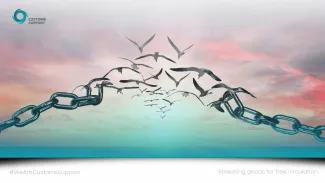How Do You Bring Goods into Free Circulation?
There is a standard process for releasing goods for Free Circulation in the EU:
1. Goods are shipped to the EU and taken off the vessel or aircraft. They can be stored temporarily until European Customs Authorities have completed import clearance.
2. The importing company, economic operator or declarant consults TARIC* for applicable documentation. This includes ensuring there are no restrictions or prohibitions on the goods in the shipment. Examples of supporting documents include import licences, certificates of origin, and commercial invoices. The Customs Authority receives and reviews these documents when the goods are presented, and they may request additional documentation if needed.
3. The Customs Authority then performs a risk assessment and in some cases inspects the goods. If the goods pass the assessment, the decision on whether they can enter free circulation is communicated to the importing company. The Customs Authority will then manage the customs debt, including customs duties determination, guarantee management and the administration.
4. The importing company or declarant pays the import duties and any other applicable charges, or makes sure the duties are covered by a guarantee. They must also handle VAT as well as anti-dumping and excise duties on the imported goods.
5. The Customs Authority then releases the goods into free circulation
Are There Import Duty Exemptions?
There are situations where import duty relief is granted:
• Returned goods – items initially exported from the EU can be sent back within three years. These are subject to clearance for free circulation of goods. To qualify, the goods must maintain their original condition, and the return shipment may comprise only a partial quantity of the exported goods.
• Inward processing of non-Union goods – involves importing them into the EU for repairing, processing, or modifying non-Union goods within the EU. This ensures they meet EU standards before entering free circulation. Once processed, these goods can either be re-exported or included in free circulation, following standard procedures. Authorisation from the Customs Authority is necessary for this inward processing arrangement.
• Products caught at sea – when an EU fishing vessel harvests fish or other products in non-EU territorial waters, these qualify for import duty exemption. This exemption also applies to products manufactured on board of such a vessel or factory ship from the EU.
Make Sure You Know Everything
This blog aims to inform and outline the process, including exceptions. It's not a comprehensive overview of releasing goods for free circulation in the EU.
For inquiries about releasing goods, contact our customs experts. We ensure you have all necessary information and assist in the free circulation release process.
* TARIC: integrated Tarrif of the European Union, multilingual database integrating all measures relating to EU customs tariff















